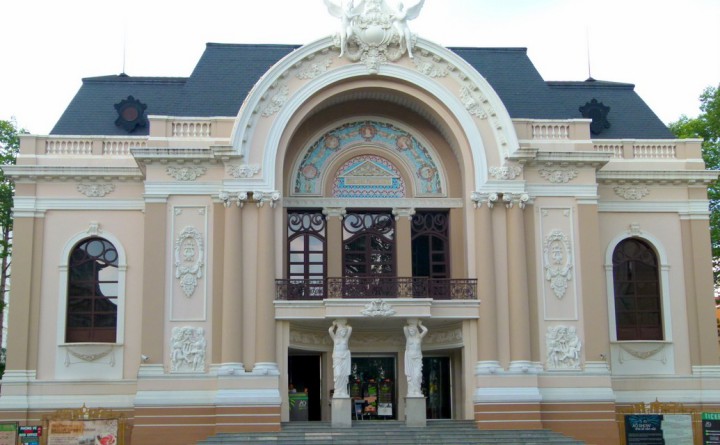This is the third in our series about the most popular tourist sites in Ho Chi Minh City. This one looks at the stunning Saigon Opera House, which sits at the end of Le Loi Street the heart of Ho Chi Minh City’s District 1.
After reviewing my series of self-guided walking tours around Ho Chi Minh City, I realized that visitors who don’t want to engage a tour guide need more information to understand these interesting sites. So here’s number 3.
Click the link to find number 1, Saigon Notre Dame Cathedral,
Number 2, Reunification Palace.
Number 4, War Remnants Museum
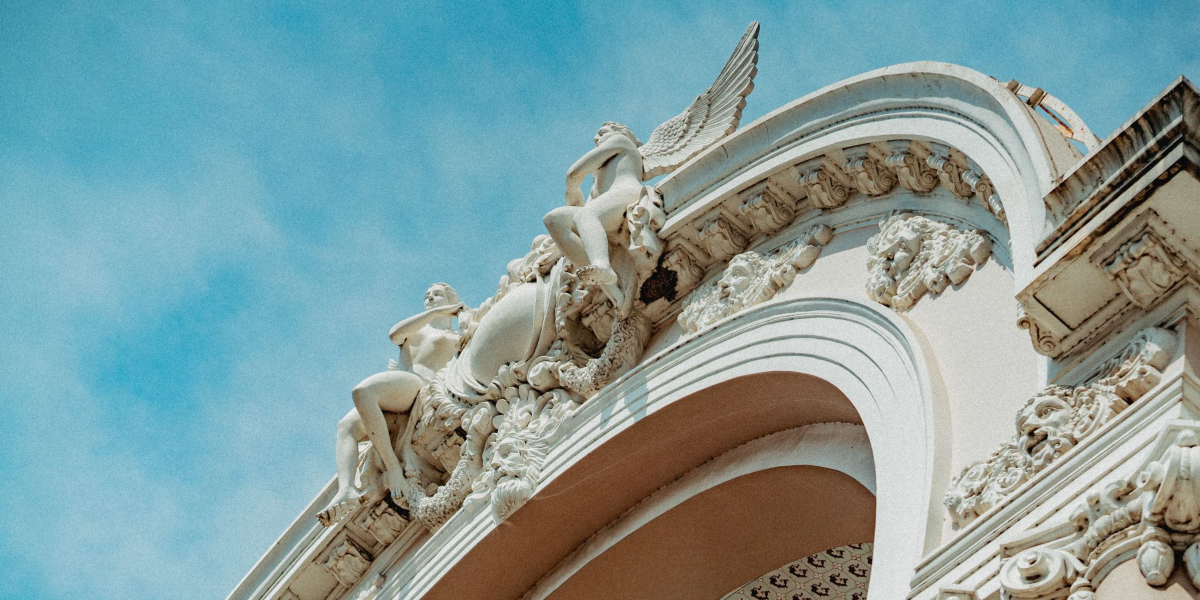
Close up of the detail at the top of Saigon Opera House
A combination of ageless charm, stunning French colonial architecture, and internationally renowned performances, Saigon Opera House is a must-see attraction for any Ho Chi Minh City travel guide.
Where Can I Find the Saigon Opera House?
You’ll find the Saigon Opera House in Lam Son Square at the start of Le Loi Street, smack bang in the center of this gigantic city. The building is officially known as the Municipal Theatre of Ho Chi Minh City.
Le Loi is a popular shopping street connecting the metro station at Ben Thanh Market (once it’s finished) with the Theatre.
Were it not for the usual crazy traffic noise, you might think the Municipal Theatre resides in one of Europe’s finest cities.
The beautiful French Colonial building is adjacent to the classical Continental Hotel and close to other impressive architectural beauties like the new Union Square shopping plaza, The Rex Hotel, and Saigon City Hall.
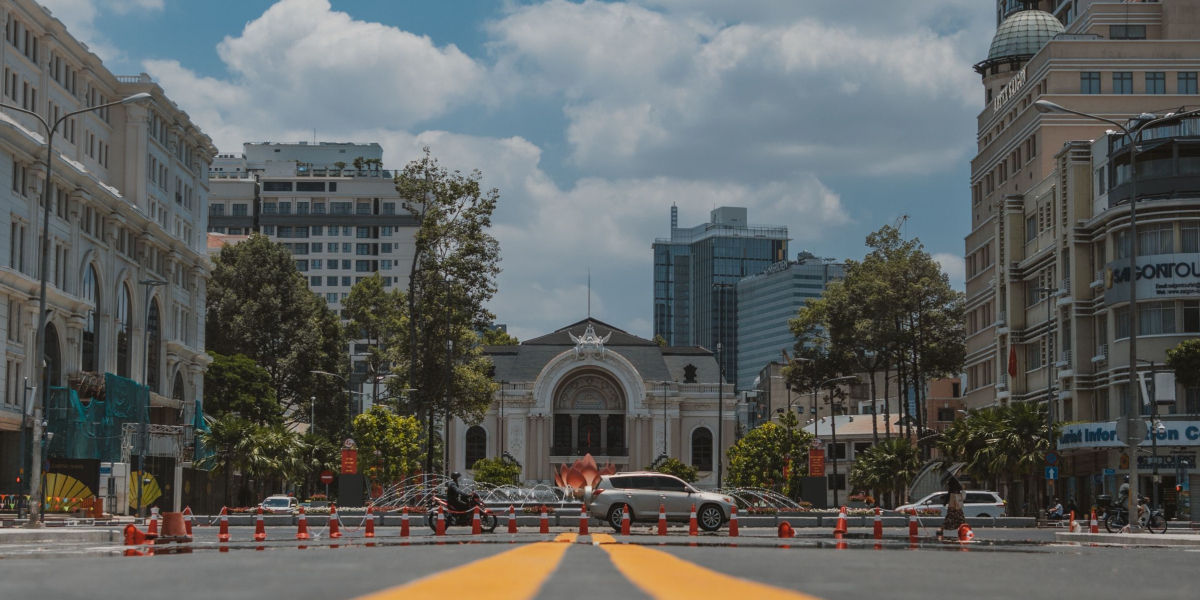
Saigon Opera House at the end of Le Loi Street
Saigon Opera House History
The Municipal Theatre’s original function was to entertain Saigon’s burgeoning French Colonial middle class. A number of French designers were involved in creating the original building that was completed in 1897.
The French architect Felix Olivier and his compatriots Ernest Guichard and Eugene Ferret are all mentioned at various design and construction stages.
The building was designed as a classical opera house and built in the “flamboyant” style of the French Third Republic.
Interestingly, the original façade resembles the Petit Palace, built the same year in France. Inscriptions and furnishings were drawn by a French artist, and the applied ornaments, cartouches, balustrades, and roofs were originally imported from France.
When the Opera House was completed in 1900, it became a focal point for entertainment activities of the city.
In the early 1940s, the theatre was considered too fancy, and many of the more ornate fixtures were removed.
During World War II, allied aerial attacks against the Japanese Imperial Army also damaged parts of the building. Fortunately, many of the original architectural features still remained.
Note: I’ve added more details on the unique architectural features of this beautiful building below.
However, the building wasn’t always used as an entertainment venue. After the French were defeated at The Battle of Dien Bien Phu and the Geneva Accords were reached, the theatre was briefly used as a shelter for French citizens emigrating from the north.
By 1956, enthusiasm for its use as an entertainment venue had waned significantly, and it was converted into the Lower House of Assembly for the South Vietnamese Government. When the Vietnam War ended in 1975, and there was no longer a need for the assembly in the new Republic of Vietnam, it was once more converted into a theatre.
In 1998, as part of Saigon’s 300th birthday celebrations, famous architects and artists were invited to assist in restoring the theatre to its former glory. The renovation was top-notch, and the complex now features state-of-the-art lighting, sound, and safety equipment.
The exterior lights were installed in 2005, so you can now get some stunning night shots.
Saigon Opera House Becomes a National Relic in 2012
In recognition of the building’s architectural and cultural importance, Ho Chi Minh City Municipal Theater was certified by the Ministry of Culture, Sports and Tourism as a national relic in 2012, putting it in the same company as Hue’s Imperial Citadel, My Son Sanctuary, and Con Dao Prison.
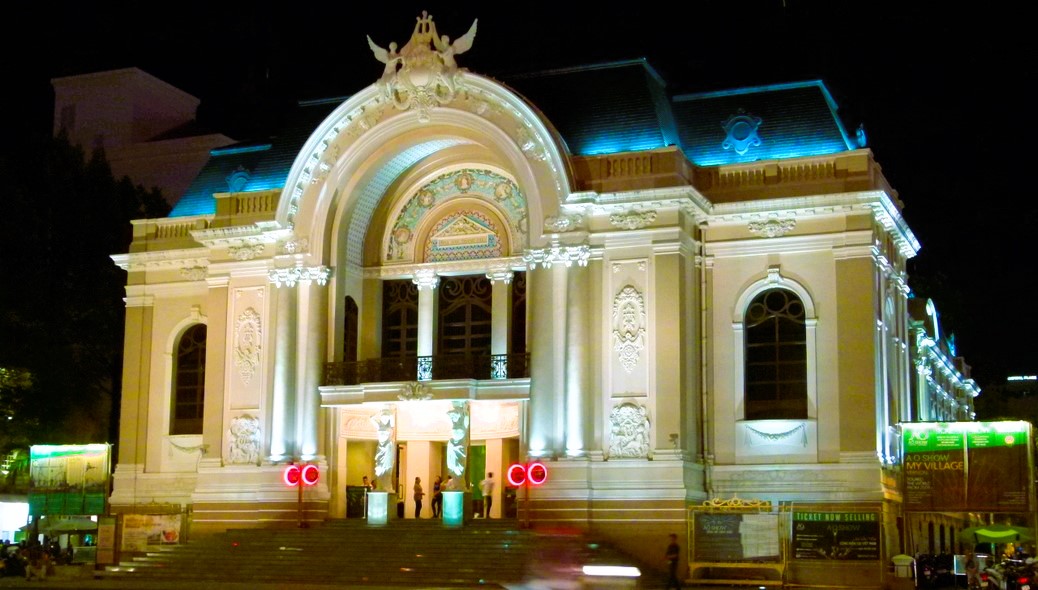
The Saigon Opera House at night
Architecture and Layout of the Saigon Opera House
Saigon’s Opera House is one of the most stunning examples of French colonial architecture in Vietnam.
Don’t just take a few snaps and move on to the next attraction. Put your camera down and take a few minutes to soak in all the different aspects of the elegant and imposing facade from different angles.
The outside of the building boasts stone-carved ornaments and statues at the entrance. The two maidens in the style of the Greek Caryatids of Erechtheion symbolize the beauty and elegance of the Opera House. The cherubs and angels give it something of the air of whimsy.
There’s no problem, as far as I’m aware, in just resting on the steps under the façade and watching the world go by in one of the loveliest areas in town. Whatever you do, don’t miss at least getting one daytime and one night picture of the Municipal Theatre. They will definitely be some of your best pics from your visit to Ho Chi Minh City.
Those fortunate enough to enter the building quickly leave the chaos of the city and traffic noise behind and are surrounded by elegant bronze statues, crystal chandeliers, and shiny granite floors.
The oval auditorium with 468 seats, is divided into three main types of seating, each at a different price point. 159 ‘aah’ seats on the flanks and second floor. 224 ‘ooh’ seats in the center of the theatre and 85 premium ‘wow’ seats on the first level.
The building is not World Heritage listed by UNESCO, but it has my vote any day.
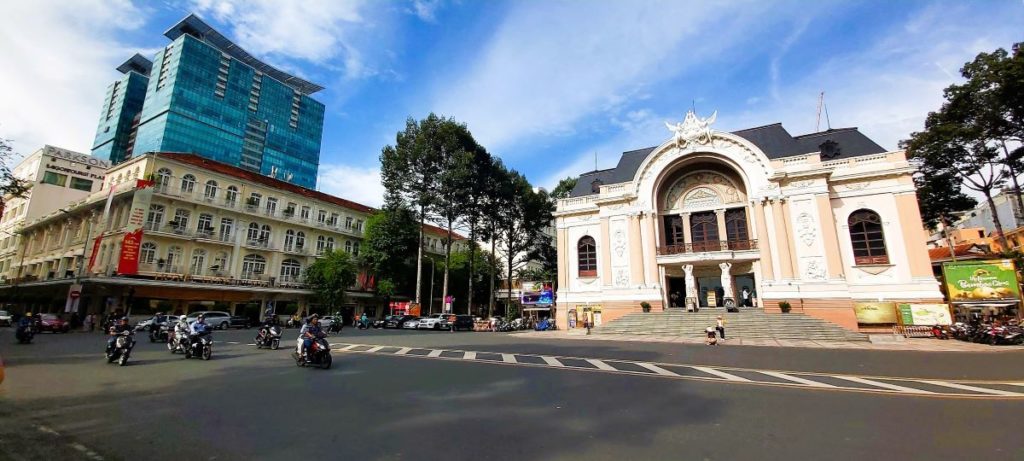
Combining stunning French colonial architecture and internationally renowned performances, Saigon Opera House is a must in any Ho Chi Minh City travel guide.
Shows at Saigon Opera House
Unless you are attending a performance of some sort, you can’t get very far into the municipal theater. But that shouldn’t be an issue if you really want to get inside.
The Municipal Theatre hosts the Ho Chi Minh City Ballet Symphony Orchestra and Opera. Hence, there are various performances showcasing the beauty and cultural richness of Vietnamese life throughout the year. These include plays, concerts, ballets, opera, circuses, and traditional Vietnamese dance.
Occasionally, you may be treated to an outdoor concert on the steps of the opera house performed by the Brass Band from the HCMC Conservatory of Music. You can usually find these performances advertised on the Saigoneer Events Calendar.
You can learn more about scheduled performances from the box office next to the Opera House. It’s open every day from 9 AM to 4:30 PM, or the official websites of the organizations I’ve described in more detail below.
Ho Chi Minh City Ballet Symphony Orchestra and Opera (HBSOVN)
Ho Chi Minh City Ballet Symphony Orchestra and Opera (HBSOVN) advertise their scheduled performances on THEIR WEBSITE (English version available) and their Facebook page.
HBSOVN is one of the leading arts organizations in the country. The orchestra was founded in 1993 and offers a variety of shows, such as ballet, opera, symphony, chamber music, and contemporary dance. They also collaborate with international artists and conductors for special performances.
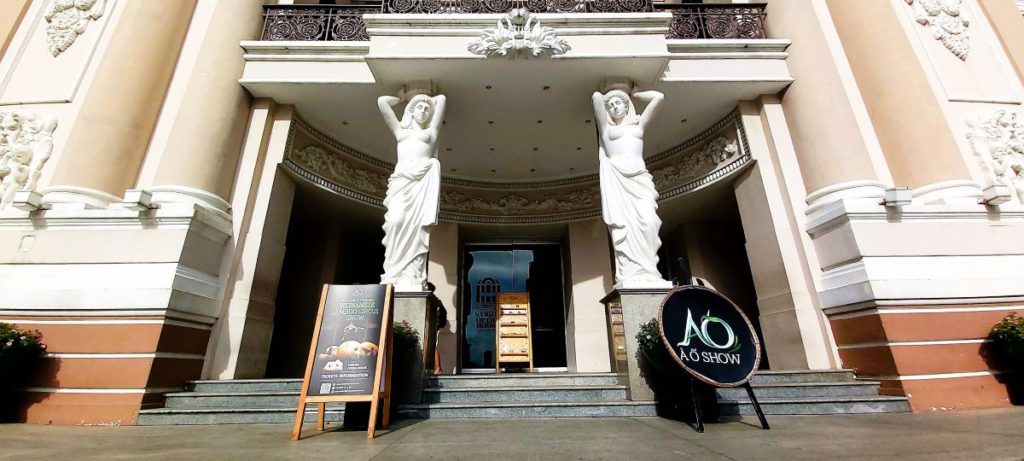
Combining stunning French colonial architecture and internationally renowned performances, Saigon Opera House is a must in any Ho Chi Minh City travel guide.
Lune Productions
Every Lune production is a fabulous fusion of bamboo cirque, acrobatic acts, and contemporary dance by skilled artists.
AO Show
If you’re visiting Ho Chi Minh City, one of their current shows, À Ố, a cross between Cirque de Soleil, martial arts, and dance, is a must-see.
The production has traveled the world to wide acclaim but is currently (as of November 2023) back on stage at the Ho Chi Minh City Municipal Theater.
The name ‘AO’ derives its meaning from ‘Lang Pho’, which means ‘village and city’. This one-hour spectacular showcases the contrast between urban and rural life in the Vietnamese countryside.
This unique mix of bamboo cirque (circus), contemporary dance, and theatrical visual art portrays rural and city scenes from Southern Vietnam and the Mekong Delta. This extremely energetic and visually stunning acrobatic performance uses rice cultivation as a metaphor for the ups and downs of .
The performers, creative set design, and colorful lighting effects illustrate the stark contrast between the beauty and cultural richness of southern Vietnamese farming life versus the nation’s racing urbanization to the audience.
While the bamboo props are simple, they perfectly complement the incredible acrobats and their contortions, juggling, and daring stunts. There is no language barrier as the story is communicated with body language, humor, and perfectly scripted interactions between the performers.
The sensational live music combines traditional and contemporary tunes, including Vietnamese southern work songs, is played with 17 different musical instruments.
Lune Productions in Other Parts of Vietnam – Teh Dar
On a side note. Lune Productions also has another production, currently playing in Hoi An. The venue is the Hoi An Lune Center in the heart of Hoi An Ancient Town.
The show, Teh Dar, explores the exotic Vietnamese tribal cultures and the circle of tribal life.
Teh Dar is a word in the K’Ho language that means ‘traveling the circle’ – representing the birth-death-rebirth cycle of every living thing.
Like the AO show in Ho Chi Minh City, the performers use bamboo circus, daring acrobatics, juggling, dance, and live music to depict the vibrant tribal life of the South West Highland of Vietnam.
The audience is treated to the charming beauty and cultural richness of Vietnam’s fascinating culture through wild animal hunts, moonlit romances, tales of death and reincarnations.
The actors are accompanied by live music from tribal instruments that have reportedly been certified as cultural heritage by UNESCO.
The Vietnamese tribal costumes, masks, and props add rich color and flare to the performance and vividly depict the area’s tribal culture and the enchanting world of Vietnamese highlanders.
Like the AO show, Teh Dar is now internationally renowned after touring in several other countries.
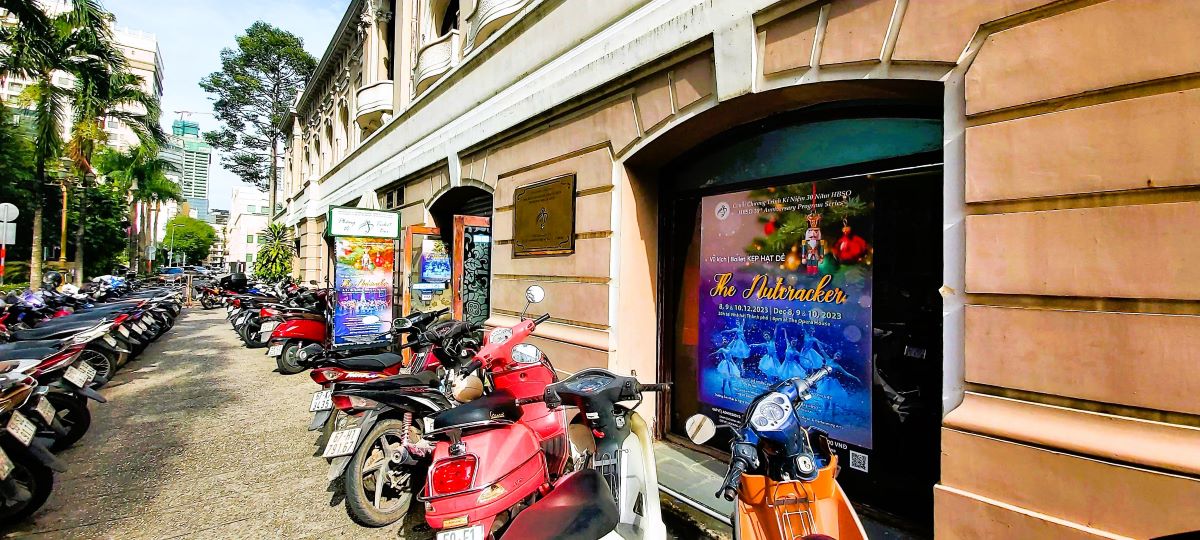
The ticket office for the HBSOVN is on the left side of the building through the parking area
Ticket Prices at the Municipal Theatre of Ho Ci Minh City
Ticket prices vary depending on the time and type of the performance and where you choose on the seating floor plan.
For example, as of November 2023, AO show tickets are:
- 800 000 VND (~ 33 USD) for an ‘Aah’ ticket,
- 1,250,00 VND (~51 USD) for an ‘Ooh’ ticket, and
- 1,750,000 VND (~72 USD) for a ‘Wow’ ticket.
You can buy your tickets for the AO show:
- At the box office, at the top of the theater’s stairs.
- From the Lune Productions Website or, like me,
- Through Get Your Guide for the same price (This site also has many other fabulous activities and experiences around town.)
To buy tickets to a performance by the HBSOVN in person, go into the motorbike park to the left of the building, and you’ll see the ticket office through the first door on your right.
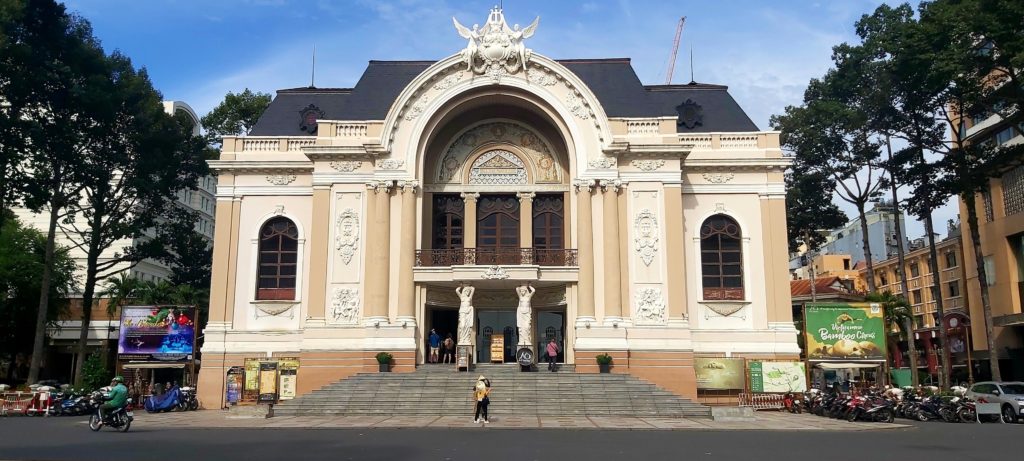
Combining stunning French colonial architecture and internationally renowned performances, Saigon Opera House is a must in any Ho Chi Minh City travel guide.
After The Show – My Summary Travel Guide
Saigon Opera House’s central location right in the heart of Ho Chi Minh City makes it easy to incorporate a visit or performance into a fuller itinerary.
Enjoying the Nguyen Hue Pedestrian Street
After the show, it’s a short walk to Nguyen Hue Pedestrian Street and its many bars, restaurants and cafes. Not to mention some of Ho Chi Minh City’s best selfie spots if that’s what floats your boat.
Shopping at Ben Thanh Market
Most performances finish early enough for you to head down and enjoy the Ben Thanh night market with all it’s hustle and bustle. As mentioned in the intro, Le Loi will lead you straight there.
Visiting the Independence Palace
You’d probably visit Independence Palace before an evening show as it closes at 4.30 pm. But this is another must-see on your visit to Ho Chi Minh City, so don’t miss it. You can read all about it HERE.
Visiting Saigon Notre-Dame Cathedral
Current renovations mean entry to the Cathedral is limited. However, they still hold mass; if you get the right angle, you can still take external pictures without getting the scaffolding in a frame. You can see all the details here.
Visit the Theater as Part of a Full-Day Walking Tour
I’ve incorporated all of these important Ho Chi Minh City attractions in my Free Self-Guided Walking Tour, that takes in all the popular sites around District 1, including Saigon’s Opera House.
Walking Tour 2 goes a little further afield and visits some less visited but still fascinating sites in central Saigon.
Under each walking tour, I’ve added some other suggestions on what you might do on your visit to both Ho Chi Minh City and Vietnam in general. And if you want to know more, then head on over to our Vietnam Page which lists a heap of other resources and information.
And finally, if you want to stay in the loop, sign up for the TRAVEL BUG TIMES and travel better for less.
Each issue contains:
-
- travel tips from experts,
- lessons from the road,
- great deals, and
- carefully curated products and services.
Vietnam Travel Guide
Traveling to Vietnam but don’t know where to start? This travel guide has everything you need to start planning your adventure in this amazing country.
Lonely Planet Vietnam
Lonely Planet’s Vietnam is your passport to the most relevant, up-to-date advice on what to see and skip, and what hidden discoveries await you.
Rough Guide Vietnam
A practical travel guide to Vietnam featuring detailed travel tips and points of interest, lists of all iconic must-see sights, and off-the-beaten-track treasures.
Heading to Vietnam Soon?
Check out our Travel Resource pages before you start planning and booking. Everything you need in one place to save you money and travel better.
And more…
Book Your Flight
Use WayAway to find cheap flights. They are our favorite search engine because they search websites and airlines around the globe. (Including the tiny budget ones many other search engines ignore.)
Book Your Accommodation
To find the best deals and book most of our accommodation (when we’re not housesitting,) we use:
-
- WayAway
- Booking.com, and
- Agoda
If you are more into Hostels, then Hostelword is the biggest platform for those.
Don’t Forget Travel Insurance
Travel insurance will protect you if anything goes wrong before or during your trip. We never travel without it and have needed it many times. We’ve used a few companies with excellent results over the years.
Consider:
- Covermore (Australians)
- Safety Wing (All nationalities. Great for long-term travelers and Digital Nomads.)
- World Nomads (All nationalities. Great for long-term travelers and Digital Nomads.)
- Visitors Coverage (to see a more extensive range of available plans from different providers, including policies for over 60’s.)

